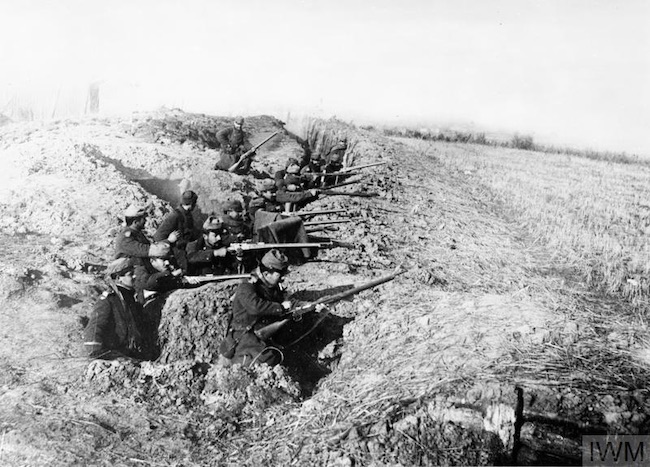Warfare of WWI |
| Introduction |
| Trench Warfare |
| New Weapons |
| Industrialization |
| Total War |

-
The Origins of Trench Warfare: Trench warfare emerged as a result of the stalemate that developed on the Western Front early in the war. As opposing armies faced each other, both sides sought protection from the devastating firepower of machine guns, artillery, and other weaponry. Trenches, initially intended for temporary shelter, eventually evolved into an extensive and complex system of interconnected defensive positions.
-
Life in the Trenches: Life in the trenches was characterized by unimaginable hardships. Soldiers endured unsanitary conditions, constant exposure to the elements, and the omnipresent fear of death. The trenches were often muddy and infested with rats, lice, and other disease-carrying creatures. Soldiers faced the constant threat of enemy attacks, sniper fire, and the deadly presence of gas attacks, making it a relentless struggle for survival.
-
Trench Warfare Tactics: Both sides in the conflict developed specific tactics to gain an advantage in trench warfare. Infantry assaults, often preceded by heavy artillery bombardments, aimed to break through enemy lines. Strategies such as "over the top" assaults involved troops leaving the relative safety of the trenches to charge across No Man's Land, the perilous expanse between the opposing trenches. These assaults were met with intense machine gun fire, resulting in staggering casualties.
-
Innovations in Trench Warfare: In response to the challenges of trench warfare, new weapons and tactics were developed. Armored vehicles, such as tanks, were introduced to break through enemy lines and overcome the obstacles of barbed wire and trenches. Tunnels and underground mines were used for surprise attacks and undermining enemy positions. The use of poison gas, though controversial, became another deadly tool deployed in trench warfare.
-
Psychological Impact: The prolonged exposure to the horrors of trench warfare took a severe toll on the soldiers' mental well-being. The constant stress, fear, and the witnessing of immense suffering led to the development of conditions such as shell shock (now known as post-traumatic stress disorder). The psychological impact of trench warfare had profound and long-lasting effects on the soldiers, many of whom struggled to readjust to civilian life after the war.
-
The Legacy of Trench Warfare: Trench warfare left an indelible mark on World War I and subsequent conflicts. Its enduring image became a symbol of the futility and brutality of war. The lessons learned from trench warfare contributed to changes in military strategies and the development of new tactics in future conflicts. The experience of trench warfare also played a significant role in shaping public opinion and contributing to a collective desire for peace and the prevention of future wars.
World War I was a conflict marked by a grueling and relentless form of warfare known as trench warfare. The intricate network of trenches, stretching across the Western Front, became the defining feature of the war.